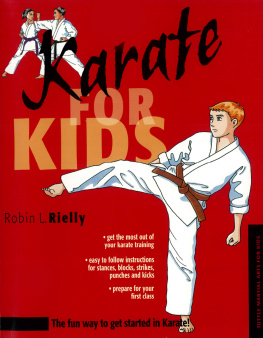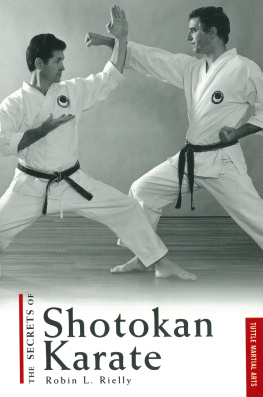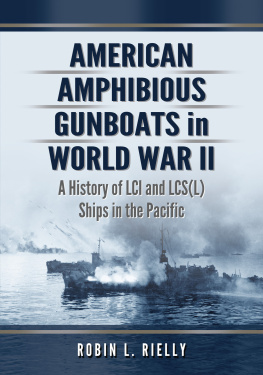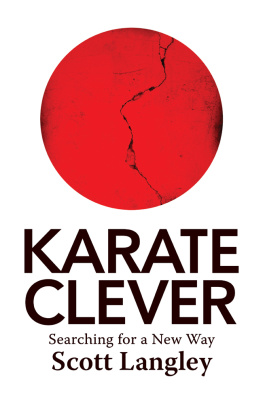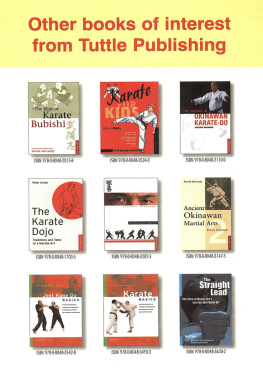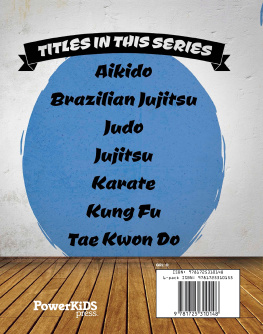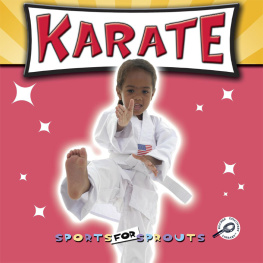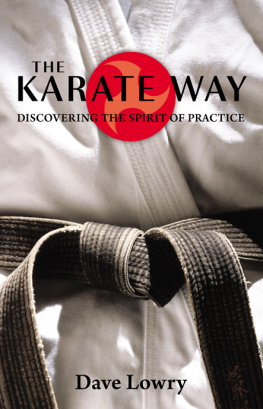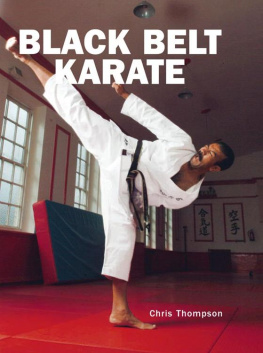Robin L. Rielly - Karate for Kids
Here you can read online Robin L. Rielly - Karate for Kids full text of the book (entire story) in english for free. Download pdf and epub, get meaning, cover and reviews about this ebook. publisher: Tuttle Publishing, genre: Religion. Description of the work, (preface) as well as reviews are available. Best literature library LitArk.com created for fans of good reading and offers a wide selection of genres:
Romance novel
Science fiction
Adventure
Detective
Science
History
Home and family
Prose
Art
Politics
Computer
Non-fiction
Religion
Business
Children
Humor
Choose a favorite category and find really read worthwhile books. Enjoy immersion in the world of imagination, feel the emotions of the characters or learn something new for yourself, make an fascinating discovery.
- Book:Karate for Kids
- Author:
- Publisher:Tuttle Publishing
- Genre:
- Rating:5 / 5
- Favourites:Add to favourites
- Your mark:
- 100
- 1
- 2
- 3
- 4
- 5
Karate for Kids: summary, description and annotation
We offer to read an annotation, description, summary or preface (depends on what the author of the book "Karate for Kids" wrote himself). If you haven't found the necessary information about the book — write in the comments, we will try to find it.
Karate for Kids — read online for free the complete book (whole text) full work
Below is the text of the book, divided by pages. System saving the place of the last page read, allows you to conveniently read the book "Karate for Kids" online for free, without having to search again every time where you left off. Put a bookmark, and you can go to the page where you finished reading at any time.
Font size:
Interval:
Bookmark:

one
WHAT IS KARATE?
Y ou're probably interested in learning karate because of something you saw on television or in the movies. Most young people learn about karate that way. Or maybe your friends practice karate and you want to study with them. When you first go to the dojo (karate school), you may be surprised to find that real karate is not like the action-packed stuff you see on TV. So what is real karate? Let's take a look at the history of karate in order to understand what it really is.
 History of Karate
History of Karate
Karate and other fighting arts have been practiced for many years. What we call karate today may have begun in ancient India almost two thousand years ago. Many people believe karate was practiced by Buddhist monks in China to protect themselves against bandits. One Buddhist monk, Bodhidharma, traveled from India to China around the year A.D. 520. He settled at the Shaolin Monastery in China and taught Zen Buddhism to the monks there. He taught his fighting art to them as well. In time, the monks at Shaolin Monastery became strong fighters.
Over the next few centuries, karate spread throughout China and was practiced by many people. A number of different karate-like styles developed during this time, and karate became well known. In China, people who practiced karate called it chuan'fa or kung-fu.
The Chinese did a lot of trading with the Okinawan people, whose island-home is only a few hundred miles off the coast of southern China. In time, the people of Okinawa learned some of the fighting techniques from the Chinese and combined them with their own fighting system, called te. Since the Okinawans were ruled by the Japanese and not allowed to have weapons, they practiced karate to protect themselves. The development of karate continued on Okinawa until about 1900. At the beginning of the twentieth century, they started teaching karate in the Okinawan schools. How would you like to learn karate in your gym class?
Words to know
Chuan'fa This means "fist way." It is used as a general term for Chinese karate
Dojo Karate or other martial arts school
Kung-fu This means "to be skillful." It is another general word for Chinese fighting and is used by most people in the West to refer to Chinese martial arts
Te An Okinawan system of fighting practiced in secret before the twentieth century
Okinawa had many famous karate masters. Perhaps the best known today is Gichin Funakoshi. Master Funakoshi was a school teacher. He traveled to Japan in 1922 and gave a demonstration of Okinawan karate at a national sports show. After that, he was asked to stay in Japan to teach karate. He never gave his style an official name, he just called it "karate," which means "empty hand" or fighting without weapons. His students named it "Shotokan," and so karate had a new name in Japan. Other famous teachers came to Japan from Okinawa and started other styles of karate. Today, the most popular karate styles in Japan are Shotokan, Shito Ryu, Goju Ryu, and Wado Ryu. However, many people practice other kinds of karate as well. Some other kinds of karate are Chito Ryu, Shorin Ryu, Shudokan, and Shorinji Kempo.
Karate spread to the United States after World War II. Many servicemen were stationed in Okinawa and Japan in the 1950s and 1960s and studied karate in their free time. About that time, many Okinawan and Japanese people who knew karate came to the United States. They began to teach karate in the U.S. Since that time, karate has become very popular in the U.S. In almost every small town, there is at least one karate club, and in big cities there are usually very many.
 Why Should I Learn Karate?
Why Should I Learn Karate?
The most popular reason for learning karate is self-defense. Have you ever felt bullied or physically threatened by someone? Learning karate is a great way to feel confident that you can protect yourself in such situations. Notice that I said the idea is to protect yourself, not to harm others. If you want to practice karate so that you can hurt another person, then you are practicing for the wrong reason.
Karate is also a good way to develop self-control and physical fitness. To succeed in karate, you must discipline yourself to practice regularly and to listen carefully to what your instructor tells you. Though practicing karate can be a lot of hard work, the benefits make it worthwhile. After a couple of weeks of practice, you'll feel stronger and calmer, and you'll see your karate skills improve.
 Getting Ready for Karate
Getting Ready for Karate
Karate is a martial art, but it is very athletic. Therefore, body conditioning is important. In order to get the most from a training session, it is necessary to work as hard as possible and push yourself to the limit. You must pay close attention to the messages that your body sends. If you do not feel right during karate practice, it is a good idea to check with your doctor or school nurse to make sure that your weight is within the correct range. Remember that your body is growing and needs proper nutrition in order to perform at its best.
two
THE UNIFORM
A s soon as you enroll in a karate school, it's time to prepare for class. The first step is to become familiar with the karate uniform. Some karate schools give you a uniform when you enroll in their class, otherwise you have to buy one. In either case, it is important that you know how to wear the special uniform designed just for karate practice.
 What You Should Wear
What You Should Wear
In karate, everyone wears the same uniform for training. This special uniform is called a karate gi. The traditional karate gi is all white, and most groups wear a patch to show which club or group they belong to. Sometimes you see colored gis or ones with fancy patterns like stars and stripes. These are American inventions and are never worn by people who practice karate in Japan or Okinawa. If you are looking at a school where they wear such gis, it might not be a traditional karate school, and you might want to look for another place to train. It is not considered proper for instructors or school owners to put their names across the back of your karate gi either, so if the school that you are considering does this, the instructor may be more interested in business rather than true karate.
Karate gis are made up of pants and a jacket. The pants have either a drawstring or elastic waist. If you have a drawstring waist, after pulling the pants on, the string on either side is pulled until the waist is tight. It is then tied through the small loop in front of the pants.
The jacket has no buttons. It is fastened by strings on either side of the bottom. When you put the jacket on, make sure that the left side goes on the outside, so that the lapel goes from upper left to bottom right. Tie the strings on the bottom sides of the jacket with a square knot. This will keep the jacket from coming off. The belt is tied over the karate gi at the waist and holds everything together.
Girls usually wear a white T-shirt under their karate uniform, since the karate jacket is loose and open at the top. This should be a white, short-sleeved shirtnot long-sleeved, colored, or with a collar. For boys, it is not correct to wear a shirt under the karate gi. Don't worryif the dojo is a little cold, you will warm up quickly once you begin to train.
Font size:
Interval:
Bookmark:
Similar books «Karate for Kids»
Look at similar books to Karate for Kids. We have selected literature similar in name and meaning in the hope of providing readers with more options to find new, interesting, not yet read works.
Discussion, reviews of the book Karate for Kids and just readers' own opinions. Leave your comments, write what you think about the work, its meaning or the main characters. Specify what exactly you liked and what you didn't like, and why you think so.

